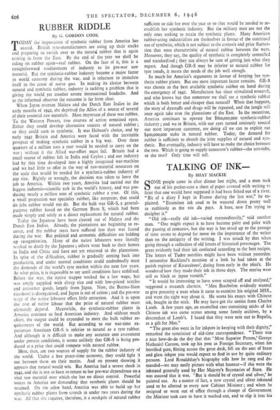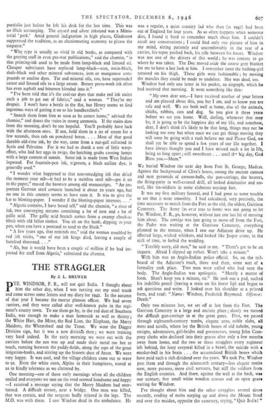TALKING OF INK
By SHAY MACKIE
SOME people came in after dinner last night, and a man took out of his pocket-case a sheet of paper covered with writing so faint that one would have supposed it had been fished out of a river. "Bit of a diary I kept in France during the last war," he ex- plained. "Estaminet ink used to be watered down pretty well as ruthlessly as the yin du pays. A bore, now I'm trying to decipher it."
"Old ink—really old ink—varied extraordinarily," said another man. "One might expect it to have become paler and paler with the passing of centuries, but the way it has stood up to the passage of time seems to depend far more on the importance of the writer than on the antiquity of the writing. I was struck by that when going through a collection of old letters of historical personages. The great evidently had their ink confected according to the best recipes. The letters of Tudor notables might have been written yesterday. I remember Buckland's mention of a look he had taken at the parish register of Knaresboro', dating from early in the r600's. He wondered how they made their ink in those days. The entries were still as black as japan varnish."
"It would be interesting to have some scraped off and analysed," suggested a research chemist. "Max Beerbohm evidently wanted to give posterity a treat when it came to examine his original MSS., and went the right way about it. He wrote his essays with Chinese ink, bought in the stick. He may have got the notion from Charles Lamb. A few years ago, an enamelled case containing sticks of his Chinese ink was come across among some family archives, by a descendant of Lamb's. I heard that they were sent out to Rapallo, as a gift for Max."
"The great also went in for inkpots in keeping with their dignity," remarked the scrutiniser of old-time correspondence. "There was a nice how-de-do the day that that Most Superior Person,' George Nathaniel Curzon, took up his post as Foreign Secretary, when his horrified gaze, flitting across the great desk, fell on the sort of brass and glass inkpot you would expect to find in use by quite ordinary persons. Lord Ronaldshay's biography tells how he rang and de- manded—we may easily picture with what hauteur—if this were the inkstand generally used by Her Majesty's Secretaries of State. He was assured that it was. But it should be of crystal and silver,' he pointed out. As a matter of fact, a new crystal and silver inkstand used to be allotted to every new Cabinet Minister ; and when he resigned or went out of office through a change of Government, the Minister took care to have it washed out, and to slip it into his portfolio just before he left his desk for the last time. This was no illicit scrounging. The crystal and silver inkstand was a Minis- terial 'perk.' Amid general indignation in high places, Gladstone suppressed the tradition, as an electioneering economy to please the taxpayer."
"Why type is usually so vivid in old books, as compared with the greying stuff in even pre-war publications," said the chemist, "is that printing-ink used to be made from lamp-black and linseed oil. Cheaper substitutes have replaced lamp-black—soot, resin-black, shale-black and other mineral substances, iron or manganese com- pounds or analine dyes. Tar and mineral oils, too, have supersede.i castor and linseed oils to a large extent. Rotary press-work ink often has even asphalt and bitumen blended into it."
"I've been told that it's the coal-tar dyes that make red ink stains such a job to get out of fabrics," said a woman. "They're my despair. I won't have a bottle in the flat, but Henry seems to find ingenious ways of getting it on to his handkerchiefs."
"Snatch them from him as soon as he comes home," advised the chemist," and douse the stains in strong ammonia. If the stains date from the morning, don't be too hopeful. You'll probably have luck with the afternoon ones. If not, hold them in a jet of steam for a few seconds, then rub on powdered borax. . . . Most of that good durable old-time ink, by the way, came from a nut-gall collected in Syria and Palestine. For it we had to thank a sort of little wasp- effect, who laid her eggs in twigs, the hatching grubs causing lumps with a large content of tannin. Some ink is made from West Indian logwood. For fountain-pen ink, nigrosen, a black aniline dye, is generally used."
"I wonder what happened to that non-smudging ink that dried the moment your nib—it had to be a stainless steel nib—got it on to the paper," mused the browser among old manuscripts. "An im- portant German steel concern launched it about 20 years ago, but no one in this country seems to have seen it. It was to give the k.o to blotting-paper. I wonder if the blotting-paper interests. .. ."
"Algeria contains, I have heard tell," said the chemist, "a river of ink, two converging streams containing a lot of iron and a lot of gallic acid. The gallic acid branch comes from a swamp chock-a- block with old fallen timber. You sit on the bank, dipping in your pen, when you have a postcard to send to the Sheik."
"A few years ago, that reminds me," said the woman troubled by red ink stains, "one of our ink kings died, leaving a couple of hundred thousand. . . ."
"Alt, but it would have been a couple of million if he had im- ported his stuff from Algeria," submitted the chemist.



































 Previous page
Previous page